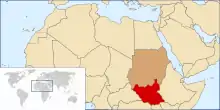Southern Sudan Autonomous Region (1972–1983)
The Southern Sudan Autonomous Region was an autonomous region that existed in Southern Sudan between 1972 and 1983.[1] It was established on 28 February 1972 by the Addis Ababa Agreement which ended the First Sudanese Civil War.[2] The region was abolished on 5 June 1983 by the administration of Sudanese President Gaafar Nimeiry.[3] Revocation of southern autonomy was one of the causes of the Second Sudanese Civil War which would continue until January 2005, when southern autonomy was restored.
| Southern Sudan Autonomous Region | |||||||||
|---|---|---|---|---|---|---|---|---|---|
| Autonomous region of Sudan | |||||||||
| 1972–1983 | |||||||||
 Location of Southern Sudan (red) and the rest of Sudan (brown) in central / northern Africa. | |||||||||
| Capital | Juba | ||||||||
| Area | |||||||||
• 1983 | 619,745 km2 (239,285 sq mi) | ||||||||
| Population | |||||||||
• 1983 | 5466700 | ||||||||
| History | |||||||||
| February 28 1972 | |||||||||
• Region abolished | June 5 1983 | ||||||||
| |||||||||
| Today part of | |||||||||
Government and politics
Southern Sudan was governed by a High Executive Council which was led by a President of the High Executive Council. Abel Alier was the first President, holding that post between 1972 and 1978.
Legislative authority was vested in a People's Regional Assembly.
The autonomous region consisted of the three provinces of Equatoria, Bahr al-Ghazal, and Greater Upper Nile. Juba was the regional capital.
Presidents of the High Executive Council
| Tenure | Incumbent | Party |
|---|---|---|
| 6 April 1972 – February 1978 | Abel Alier | Southern Front |
| February 1978 – 12 July 1979 | Joseph Lagu | Sudan African National Union |
| 12 July 1979 – 30 May 1980 | Peter Gatkuoth | Southern Sudan |
| 30 May 1980 – 5 October 1981 | Abel Alier | Southern Front |
| 5 October 1981 – 23 June 1982 | Gismalla Abdalla Rassas | Southern Sudan Liberation Movement |
| 23 June 1982 – 5 June 1983 | Joseph James Tombura | Sudan African National Union |
Post-abolition
The Southern Sudan Autonomous Region was abolished in 1983. Between 1987 and 1989 a Council for the South existed in Southern Sudan. Following the signing of the Khartoum Peace Agreement of 1997, a Southern Sudan Coordination Council was established initially led by Riek Machar who was also appointed Assistant to the President of the Republic. [4] This body was abolished in 2005 when the Autonomous Government of Southern Sudan was established.[5]
See also
- South Sudan
- Comprehensive Peace Agreement
- Government of Southern Sudan (2005–2011), the autonomous government that existed between 2005 and independence in 2011
- Southern Sudanese independence referendum, 2011
References
- Ben Cahoon. "The Sudan". Worldstatesmen.org. Retrieved 2016-02-29.
- "武蔵村山市新築図録 | 武蔵村山市には新築がいっぱい♪" (PDF). Splamilitary.net. Archived from the original (PDF) on 2012-07-10. Retrieved 2016-02-29.
- https://web.archive.org/web/20110716052232/http://www.pachodo.org/201010061749/Pachodo.org-English-Articles/history-of-southern-sudan-hoss.html. Archived from the original on July 16, 2011. Retrieved January 11, 2011. Missing or empty
|title=(help) - https://peacemaker.un.org/sites/peacemaker.un.org/files/SD_970421_SudanPeaceAgreement.pdf
- Ben Cahoon. "Southern Sudan". Worldstatesmen.org. Retrieved 2016-02-29.